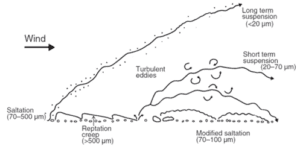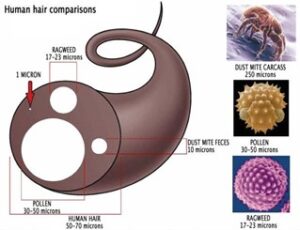Understanding Dust: Classification, Behavior, and the Role of Wind in Dispersion
Dust is a complex array of tiny particles that can impact our health and productivity, especially in industry where harmful dust generated by work processes and eroding stockpiles is an ever-present challenge. Dust originates from a vast array of sources with each type of dust behaving differently based on its chemical composition, size, shape, strength and aerodynamic properties. This blog will explore how dust is classified and how wind impacts it.
About Dust
Dust is defined by the International Standards Organization as “small solid particles, conventionally taken as those particles below 75 microns in diameter, which settle out under their own weight but which remain suspended for some time3”. Note that a micron also referred to as a µm is a metric unit of length where 1µm equals 0.001mm or 1/25,400 of an inch. The World Health Organization refers to dust as “solid particles ranging in size from below 1µm to around 100µm, which may be or become airborne, depending on their origin, physical characteristics and ambient conditions4.” For context, the thickness of a human hair is approximately 60µm20 and particles that are visible to the naked eye hover at around 40µm.
Source: Srivastava, T. “Particles to Solid Surfaces” University of Newcastle October 2022
Dust can be categorized as either respirable or inhalable. Inhalable dust is visible dust that is generally 10µm – 100µm in size6 and may cause illness or damage to the upper respiratory tract. Respirable dust contains particles which are less than 10µm in size and can be inhaled deep into the lungs1 and alveoli. These respirable particles are not visible to the naked eye.
Dust may additionally be categorized based on chemical composition: inorganic and organic5. Inorganic dust is derived from grinding or breaking up materials such as rock or metals and includes other potentially harmful materials which may consist of silica, coal, natural stone, tungsten, aluminium, or beryllium7. Organic dust, on the other hand, may arise from handling plant or animal-based products such as wood or grain. Due to their derivation, organic dust may also contain fungi and other microbes or endotoxins which can cause detrimental health effects5. Based on chemical composition, inorganic dust tends to be more dense than organic dust, although there may be exceptions dependent on the particular materials involved.
Density, particle shape and particle size effects how the dust behaves in the air. Particles that are smaller in size require less dust lift off velocity to become airborne than that of larger particles. Larger, denser, and rounder particles generally remain airborne for a shorter period of time compared to smaller particles due to their weight and increased force of gravity acting on them. Equally, particles that are shaped like a piece of paper (as an extreme example) lift more easily than something smooth and round like a bowling ball. Irregularly shaped particles tend to have a larger surface area which drastically impacts their aerodynamic behaviour. These irregularly shaped particles have greater drag and less stability compared to their rounder more spherical-shaped counterparts which leads to slower speeds when airborne and, as a result, faster settling.
In addition to the physical properties of dust, electrostatic charges acquired by dust particles also impact their behaviour. As dust particles come in contact with other particles and surfaces, they may acquire either positive or negative charges. As opposites attract, positively charged dust is attracted to negatively charged objects and vice versa.
Where Does Dust Come From?
Dust comes from a variety of sources which includes indoors, outdoors, and believe it or not, cosmic sources! Dust is generally made up from microscopic particles of sand, soil, organic tissue and manufactured materials8, or a combination thereof. It may also contain bacteria, ash, pollen and salt crystals (from the ocean)9. Dust is literally found everywhere on the planet, from kitchen countertops to the surfaces of leaves in the forest and from floating around in the atmosphere to industrial sites. To provide context, every drop of rain contains a speck of dust which is critical to its formation and existence17. The average person inhales approximately 70,000 particles with each breath, 4 of which are estimated to be space particles that have not come into contact with anything terrestrial before.
Atmospheric dust, also known as atmospheric aerosols or atmospheric particles, is dust and particulate matter that is found in the air surrounding the earth11. It is typically composed of materials from naturally weathering rocks, eroding soil, emissions from combustible engines, industrial operations found in mining and petroleum refineries, as well as cosmic material falling to earth; just to name a few10. Dust within our homes and other buildings is generally made up of dead human skin cells, dirt that has been tracked in, and dust mites. It is estimated that two-thirds of indoor dust is derived from outdoor dust and air pollution with the remaining one-third from indoor sources8.
For atmospheric dust in particular, it has been shown that 70% of the dust in the air is produced by the wind whereas industrial dust and pollution accounts for 25-30%12. It is important to note that the number of particles dispersed in the atmosphere decreases with an increase in particle size12.
Mineral, metallic, organic, and biohazards are examples of dust commonly found in an industrial setting. These types of dust may be generated by work-related processes and have various impacts on employee health and safety based on their aerodynamic behaviour. Industrial dust is released or generated whenever workplace activities require handling of materials2 by transferring, moving, mixing, conveying, and other tasks, or when wind or other environmental factors are at play.
Other major contributors to global dust levels are the Sahara and Gobi Deserts. These deserts disperse hundreds of millions of tonnes of aeolian dust (windblown silt and clay) into the environment each year. The dust generated travels across oceans and impacts ecosystems and weather patterns worldwide.
How Does Wind Affect Dust?
Wind direction and speed play an important role in dust dispersion. The concentration of dust is inversely proportional to the wind speed12. In other words, as the wind speed increases, the dust concentration for a given volume decreases, and vice versa (with the exception of dust storms). The greater the wind speed, the larger the area that the dust particles are dispersed into as the wind allows for the dust to be carried farther thus spreading the dust out. The image below illustrates this concept.

Figure from Yilbas, B., Al-Sharafi, A., Ali, H., “Environmental Dust on Surfaces” Self-Cleaning of Surfaces and Water Droplet Mobility 2019 pp 114.
The influence of the wind on dust dispersion is also relative to the direction of the wind and the wind velocity. Under lower wind speeds, dust particles bounce along the ground by a process referred to as saltation. As the wind speed increases the smaller particles are lifted into the air and carried away. The stronger the wind speeds and smaller the dust particle size, the further it will travel. Smaller particles (<20µm) are suspended for longer periods of time and can travel thousands of kilometres, whereas particles in the 20-70µm range are suspended for a shorter period of time and tend to settle closer to the source. As wind speeds slow, the dust particles eventually lose their momentum and settle under gravity.

Figure from Kok, J., Parteli, E., Michaels, T. et al “The physics of wind-blown sand and dust” Rep. Prog. Phys 75 106901
Turbulence is another consideration when considering dust dispersion. Turbulent air can be thought of as the proportion of the flow of vertical wind to the flow of horizontal wind. Turbulent air is erratic. The air is not moving in the same direction, rather, it is moving irregularly with swirling eddies and spiralling motions causing fluctuations in speed, pressure, and direction. Due to its unpredictable nature, turbulence allows dust particles to be suspended for longer periods and transported over greater distances. In general, the closer to the ground, the higher the degree of turbulence. Turbulence is caused by a variety of factors such as wind shear, buildings and other obstacles, convective currents (warm air rising and cold air sinking), and jet streams.
As the wind moves dust particles around dust comes in contact with objects and surfaces. Electrostatic charges are acquired by dust particles through friction (triboelectric effect), air movement and collision with objects. These now-charged dust particles adhere to surfaces due to van der Waals forces, Coulomb forces, surface tension and textures. On solid barriers, this may appear as though the dust is “climbing” the wall.
Food For Thought
Dust is a complex issue with significant implications. The classification of dust based on its size, chemical composition, and aerodynamic properties helps us better understand its behaviour and develop more effective ways to manage it. Consider the experiment conducted by Galileo in the late 1500’s with a feather and a coin. He determined that in the absence of air resistance, when dropped these two very different objects hit the ground simultaneously. This, of course, only occurs in a vacuum, and in the real world where air has an impact, other factors must be considered. Wind is a primary driver of dust movement, influencing how it is lifted, transported, and eventually deposited. By studying these factors and implementing appropriate measures, we can better manage dust-related challenges and find solutions or sets of solutions that keep the dust under control.
References and Reading Materials:
- Hazardous Dusts https://www.worksafe.qld.gov.au/safety-and-prevention/hazards/hazardous-exposures/hazardous-dusts Accessed Sep 23, 2024
- World Health Organization “Hazard Prevention and Control in the Work Environment: Airborne Dust” December 1999 https://www.who.int/publications/i/item/WHO-SDE-OEH-99-14 Accessed September 23, 2024
- ISO 4225 https://www.iso.org/obp/ui/#iso:std:iso:4225:ed-2:v1:en Accessed Sep 23, 2024
- World Health Organization “Hazard Prevention and Control in the Work Environment: Airborne Dust” December 1999 https://www.who.int/publications/i/item/WHO-SDE-OEH-99-14 Accessed September 23, 2024
- Canadian Centre for Occupational Health and Safety “Chemicals and Materials” https://www.ccohs.ca/oshanswers/chemicals/lungs_dust.html Accessed Sept 23, 2024
- CCOHS “Weather – High Winds” https://www.ccohs.ca/oshanswers/safety_haz/weather/high_winds.html Accessed August 8, 2024
- Queensland Government “Notifiable Dust Lung Diseases” https://www.qld.gov.au/health/staying-healthy/workplace/notifiable-dust-lung-diseases#:~:text=Examples%20of%20inorganic%20dust%20include,%2C%20cobalt%2C%20aluminium%20and%20beryllium. Accessed September 24, 2024
- https://www.britannica.com/science/dust Accessed November, 12, 2024
- https://education.nationalgeographic.org/resource/dust/ Accessed November 12, 2024
- Liu, H., Cao, F., Guang-Ling, S., et al. Review of the atmospheric corrosion of magnesium alloys. Journal of Materials Science & Technology. Volume 35 Issue 9 September 2019, Pages 2003-2016.
- Xu, Z., Airborne Particles in Outdoor Air: Atmospheric Dust. Fundamentals of Air Cleaning Technology and Its Applications in Clean Rooms. 2013 Aug 14:47-132
- Yilbas, B., Al-Sharafi, A., Ali, H., “Environmental Dust on Surfaces” Self-Cleaning of Surfaces and Water Droplet Mobility 2019 pp 99-132.
- Wind Rose https://en.wikipedia.org/wiki/Wind_rose#:~:text=Using%20a%20polar%20coordinate%20system,greatest%20frequency%2C%20the%20prevailing%20wind. Accessed Nov 12, 2024
- Return Period https://en.wikipedia.org/wiki/Return_period Accessed Nov 12, 2024.
- Le, C., Yang, W. “Time-Dependent Reliability Theory and Its Applications” 2023 pp121-182
- Mishra, A., “Technical Note: Windspeed Averaging Times” The Wind Engineer: Newsletter of American Association for Wind Engineering. March 2007.
- https://www.britannica.com/video/role-impurities-salt-dirt-soot-formation-raindrops/-203976#:~:text=Somewhere%20inside%20of%20every%20raindrop,crucial%20to%20the%20raindrop’s%20existence. Accessed Nov 19, 2024.

Claire Cowie is a seasoned Quality Assurance Manager with over two decades of experience in healthcare and manufacturing. Her career began in pharmacy, where she led teams and honed her skills in quality management systems. As she transitioned to the manufacturing sector, her unique background combines a deep understanding of policy and quality assurance with a keen eye for quality control.
Claire has been instrumental in implementing and cultivating a comprehensive quality control program within WeatherSolve Structures. She has successfully integrated her pharmaceutical background with manufacturing best practices, particularly in areas such as Good Manufacturing Practices (GMP) and ISO 9001 standards. Her unique blend of experience continues to drive innovation and excellence in her role.

